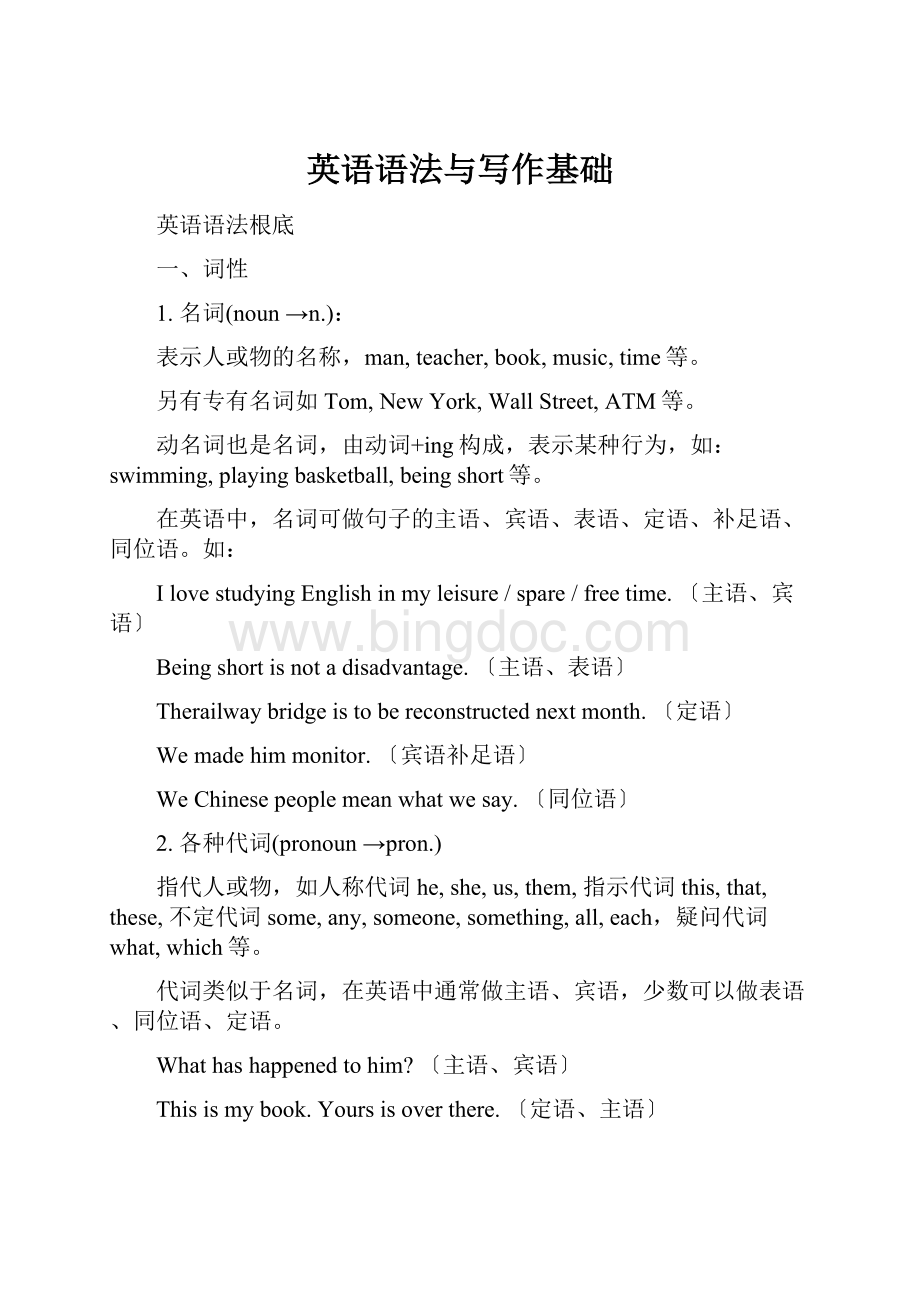英语语法与写作基础.docx
《英语语法与写作基础.docx》由会员分享,可在线阅读,更多相关《英语语法与写作基础.docx(20页珍藏版)》请在冰点文库上搜索。

英语语法与写作基础
英语语法根底
一、词性
1.名词(noun→n.):
表示人或物的名称,man,teacher,book,music,time等。
另有专有名词如Tom,NewYork,WallStreet,ATM等。
动名词也是名词,由动词+ing构成,表示某种行为,如:
swimming,playingbasketball,beingshort等。
在英语中,名词可做句子的主语、宾语、表语、定语、补足语、同位语。
如:
IlovestudyingEnglishinmyleisure/spare/freetime.〔主语、宾语〕
Beingshortisnotadisadvantage.〔主语、表语〕
Therailwaybridgeistobereconstructednextmonth.〔定语〕
Wemadehimmonitor.〔宾语补足语〕
WeChinesepeoplemeanwhatwesay.〔同位语〕
2.各种代词(pronoun→pron.)
指代人或物,如人称代词he,she,us,them,指示代词this,that,these,不定代词some,any,someone,something,all,each,疑问代词what,which等。
代词类似于名词,在英语中通常做主语、宾语,少数可以做表语、同位语、定语。
Whathashappenedtohim?
〔主语、宾语〕
Thisismybook.Yoursisoverthere.〔定语、主语〕
Theyeach/allgotabirthdaypresent.〔同位语。
当然,还有主语they也是代词。
〕
注意:
反身代词只能作宾语、表语、同位语,绝对不能做主语!
例如:
Hehimselfistoblameforthemistake.〔同位语〕
Heisn’thimself/doesn’tlook/feel/seemhimselftoday.〔表语〕
Heslipped,butdidn’thurthimself.〔宾语〕
3.形容词(adjective→adj./a.)
形容词的主要功能就是作定语、表语、补足语。
如:
Heissaidtobeahandsomeboy.〔定语〕
Heistall,handsome,andaboveall,veryintelligent.〔表语〕
Hefelldowntotheground,dead.〔主语补足语〕
4.副词(adverbial→adv./ad.)
副词通常做状语,修饰动词、形容词、另外一个副词、整个句子。
Heplaysthepianowell/verywell.〔修饰动词短语playsthepiano,very又修饰副词well〕
Sheisvery/really/prettybeautiful.〔修饰形容词beautiful〕
Surprisingly,hepassedtheexamatfirstattempt.〔修饰整个句子〕
注意一词多义、一词多性现象:
Shewasveryillandwasrushedtohospitalimmediately.〔形容词,“生病的〞,句中作表语〕
illeffects/discipline/temper/humor〔形容词,“不好的;糟糕的;有害的〞,只能作前置定语〕
ill-equipped/ill-treat/speakillofsb〔副词,“坏地;糟糕地〞,做状语〕
acureforallthenation’sills〔名词,“问题;困难〞,作宾语。
〕
Thebookisverygoodandworthreadingasecondtime.〔程度副词,“非常地〞,做状语。
〕
Heistheverymanforthejob.〔形容词,“恰恰是;正是〞等表示强调的意思,只能做前置定语。
〕
Heplayedtheinstrumentsowellthathewonfirstprize.〔副词,“好地〞〕
He’llgetwellsoon.〔形容词,“身体好的;健康的〞,只能作表语。
〕
Weusedtogetourwaterfromawell.〔名词,“井;水井;油井;气井〕
Withtearswellinginhiseyes,shewentaway.〔动词,“〔液体〕流出;涌出〞〕
5.介词(preposition→prep.)
英语中的介词不能单独使用,通常跟后面的宾语构成介词短语,一起做句子的状语、定语、表语、补足语。
I’llputmynameonthebackoftheenvelope.〔地点状语〕
Shedidn’trememberthenameonthebackoftheenvelope.〔后置定语〕
Hewasonholidayatthetime.〔表语、时间状语〕
Helefthiskeysinthedormitory.〔宾语补足语〕
6.连词(conjunction→conj.)
英语中的连词有并列连词和从属连词两种,分别引导并列句和从句。
并列连词主要有and,but,or,so,for;从属连词引导从句,按功能分有引导状语从句的because,since,as,although,sothat等,引导定语从句的that,which,who,whose,when,where等,还有引导名词性从句的that,who,which,whether,where等。
Wearemakinggoodprogress,butwestillhavealongwaytogo.〔引导并列句,表示转折〕
BeforeIcouldthinkofareply,shewentaway.〔引导时间状语从句〕
Sinceeverybodyishere,let’sbegin.〔引导原因状语从句〕
Whoisthemanthatissittingattheback?
〔引导定语从句〕
Thisisthehospitalwhere/inwhichshewasborn.〔引导定语从句〕
ThatnoonerememberedherbirthdayleftMariaverydepressed.〔引导名词性从句的主语从句〕
I’mdelightedthatweachievedwhatwesetouttodo.〔两个从句,分别有由that和what引导,都是名词性从句的宾语从句〕
Thequestioniswhetherwecangetintouchwithhim.〔引导名词性从句的表语从句〕
7.动词(verb→v.)
动词在英语中最复杂,有很多种分类:
1〕与物动词与不与物动词
2〕动作动词〔行为动词〕与状态动词〔静态动词,含系动词、结果动词〕
3〕实义动词与助动词〔含情态助动词〕
4〕持续动词与瞬间动词
5〕谓语动词与非谓语动词
关于动词用法下面还有论述,请参照下文。
二、英语的句子成分小结
1.主语:
由名词、代词、动名词、动词不定式、主语从句充当
Iwas/Theywereyoungandenergetic.
Who/Whatmakeshimsoupset?
Tolearn/LearningEnglishiseasy.
Whowillgothere/Whetherornotthemeetingwillbeheldisnotdecidedyet.
2.谓语:
由谓语动词来充当,有时态和语态〔主动语态与被动语态〕变化
Spendingmoneyisfun.
Hedidn’tgowithusforlackofmoney.
Ihavebeenworkingforhoursandisinneedofarest.
Thecarmusthavebeenstolen.
3.宾语:
由名词、代词、动名词、宾语从句充当
Iwanttogohomerightnow.
Iappreciateyourhelp/yourhelpingme.
Hedidn’tsaywhy/whenhewasleaving.
4.定语:
由形容词、动词不定式、现在分词、过去分词、动名词、介词短语、定语从句充当,分前置定语和后置定语两种。
Thesmallboy(sitting/seated)underthetreeisTom.
Theboy(whoisseated/sitting)underthetreeisTom.
5.补足语:
由名词、形容词、动词不定式、现在分词、过去分词、介词短语充当,有宾语补足语和主语补足语两种〕
Thenewsmademehappy/ontopoftheworld.
Hewaselected/mademonitor.
HewantedtheworktobedonebyFriday.
Whereveryougo,youseeKFCadvertised.
Hewascaughtsmokingintheworkshopandwasfiredimmediately.
6.状语:
由副词、介词短语、动词不定式、现在分词、过去分词、状语从句充当。
英语中状语的种类繁多,常见的有时间状语、地点状语、方式状语、原因状语、伴随状语、目的状语等。
Heremainedseatedthere/throughouttheparty.
Hejumpedwithjoywhenheheardthenews.
TolearnEnglishwell,youshouldreadwidely.
Dressedin/Wearingascarf,shelooksyounger.
7.表语〔系动词be和半系动词之后〕:
由名词、形容词、反身代词、现在分词、过去分词、介词短语充当
Heislikehisfather/astudent/handsome.
Thechickensmells/tastesgood.
Helooksworried/likehisfather.
Thestorysoundsinteresting.
Somethingmusthavegonewrong.
8.同位语
英语中,只有主语和宾语才可能有同位语,由名词、少数代词和同位语从句充当
Hepraisedusallinclass.〔宾语us的同位语〕
Theyall/eachgotareward.〔主语they的同位语〕
Isawthepresidenthimself.〔宾语thepresident的同位语〕
Wewereallsurprisedatthenewsthathehadresigned.〔主语we的同位语;宾语thenews的同位语从句〕
三、助动词小结
助动词主要是帮助谓语动词改变形式,如否认式、疑问式、进展式、完成式、被动式、强调式等。
1.助动词has,have,had〔后接过去分词,构成谓语动词的完成时,用于肯定句、否认句、疑问句〕
Ihavefinishedallmyhomework./Haveyoufinishedyourhomework?
---No,Ihaven’t.
ShehasgonetoShanghaitostudyChineseliterature.
Thetrainhadalreadyleftwhenshearrivedatthestation.
2.助动词is,am,are,was,were,hasbeen,havebeen,hadbeen,willbe
a)后接动词的-ing形式,构成谓语动词的进展式
Whatareyoudoingnow?
---I’mwatchingTVathome.
Twoboyswereplayingfootballnearbywhentheaccidenthappened.
IhavebeenteachingEnglishformorethan20yearsandIknowhowtosolvetheproblem.
SheisnotworkinginBeijingnow;shehasgonetoShenzhentoseekherfortune.
WewillbeflyingovertheAtlanticOceanthistimetomorrow.
b)后接过去分词,构成谓语动词的被动语态
ShewasawardedtheNobelPrizetwicein5years.
Whenhereturnedhefoundhishousehadbeenbrokenintoandalotofthings(hadbeen)stolen.
Thesuspensionbridgewillbepletednextmonth.
Ican’tlendyoumybikebecauseitisbeingrepairednow.
3.助动词do,does,did
a)后接动词原形,构成谓语动词的否认式、疑问式
Wedon’tgotoschoolonSunday.Doyou?
Shedoesn’tworkhereanylonger;shehasmovedtoShanghai.
Didyougotothecinemawithherlastnight?
---No,Ididn’t.
b)后接动词原形,构成谓语动词的强调式,常译成“确实;确实;务必〞,仅用于肯定句
Ididreturnthemoneytoyou.
ShedoesworkinthisschoolbutsheisnowinShanghaionbusiness.
Idobelievethatheisthebestmanforthejob.
Dobecarefulnexttime.
4.情态助动词can/could,may/might,must,should,will/would,shall,need,ought等。
情态助动词与上述助动词在用法唯一不同的是,情态助动词有特定的意义,表达说话人某种特定的感情,所以叫情态助动词。
You’vebeenworkingforafewhours.Youmustbetired.
Hurryup!
Theymustbewaitingforus.
Ididn’thearthephone.Imusthavebeenasleep.
Youneedn’teifyoudon’twantto.
Youneedn’thavehurried.Therewasplentyoftimeleft.
Thereisaknockonthedoor.Whocanitbe?
Ican’tfindmyumbrella.Whocanhavetakenit?
Whatshallwedonow?
Youshouldnothaveleftheraloneathomelastnight.
四、非谓语动词小结〔动词不定式、现在分词、过去分词、动名词〕
1.动词不定式〔带to〕、现在分词、过去分词都可以作状语,但动词不定式〔带to〕只能作目的状语和结果状语,其他的状语〔一般为时间状语、原因状语、条件状语和伴随状语〕用分词,其中,现在分词表示主动、过去分词表示被动。
TolearnEnglishwell,youshouldreadwidely.〔动词不定式作目的状语〕
Withthis,heleft,nevertoreturn.〔动词不定式作结果状语〕
Hearingthenews,hewaswildwithjoy.〔现在分词作时间状语,跟主语是主动关系〕
Hecamerunningtowardshismother.〔现在分词作伴随状语,跟主语是主动关系〕
Shecame,acpaniedbyhermother.〔过去分词作伴随状语,跟主语是被动关系。
〕
〔注:
动词不定式、现在分词、过去分词作状语,其逻辑主语必须是主句的主语。
〕
2.动词不定式〔带to〕、现在分词、过去分词都可以作定语,其中,动词不定式表示将来的行为,现在分词表示主动和正在进展,过去分词表示被动和已经发生。
〕
ThebridgetobebuiltnextyearwilljoinZhuhai,MacaoandHongKong.〔动词不定式作定语〕
Theboywearingglassesismynext-doorneighbor.〔现在分词作定语〕
Thestolencarwasdiscoverednearariver.〔过去分词作定语〕
需要注意的是,某些特殊结构后面只能用动词不定式作定语,它们是:
序数词、only、动作性名词,如refusal,attempt,effort,willingness,pressure等。
此时如此不用考虑时间概念。
Heisalwaysthefirsttoeandthelasttoleave.
Heistheonlyteachertounderstandme.
Iappreciateyouroffertotakemetotheairport.
另外还有一种结构being+过去分词作定语,表示一个正在进展的被动行为:
Thematterbeingdiscussedisveryimportant.
Thebridgebeingbuiltwasdesignedbyaworld-famousdesigner.
〔注:
动词不定式、现在分词、过去分词作定语,其逻辑主语必须其修饰的那个名词;动词不定式有主动和被动之分。
〕
3.动词不定式、现在分词、过去分词都可以作宾语补足语,有以下3种情况:
a〕动词不定式带to,跟在某些动词后,构成固定结构,如:
ask/tell/order/persuade/allow/forbidsbtodo,其否认式是nottodo。
变为被动结构时,宾语补足语相应变为祝语补足语。
此种用法仅限于动词不定式。
Ipersuadedhimnottogotherealone.
Wearenotallowedtosmokeatschool.
Thenovelisbelieved/isreported/issaidtohavebeentranslatedintoChinese.
b〕动词不定式〔不带to〕、现在分词、过去分词跟在感官动词see,hear,notice,observe后作宾语补足语,构成固定结构,其中,动词不定式表示动作的全过程,现在分词表示主动和正在进展,过去分词表示被动和已经发生。
Inoticedhimentertheschoolgate.
Theysawhimwalkingtowardstheschool.
Shewasfrightenedtoseetheoldmanknockeddownbyacar.
变为被动结构时,动词不定式要加to,现在分词和过去分词不变,同时宾语补足语变为主语补足语。
Hewasnoticedtoentertheschoolgate.
Theywereneverheardtohaveaquarrel.
Awomanwithtwochildrenwasseenbegginginthesquare.
c〕动词不定式〔不带to〕、现在分词、过去分词跟在使役动词let,make,have后作宾语补足语,构成固定结构,其中,动词不定式表示动作的全过程,现在分词表示持续的行为,过去分词表示被动和已经发生。
Theteacherhadmerewritemyposition.
Shemademewashthecarforaweek.
I’dliketohavethispackageweighed,please.
Hesoonhadusalllaughingathisjokes.
〔注:
从词义上来说,letsbdo=allowsbtodo,havesbdo=asksbtodo,而makesbdo=forcesbtodo,其被动式bemadetodo〔动词不定式要加to〕=havetodo:
Hewasmadetowashthecarforaweek.〕
4.动名词作主语、宾语、表语、定语
〔动名词,顾名思义是一个名词,虽然它是由动词+ing构成,但它不再是一个具体的动作,而是指一件事。
另一方面,动名词可以加宾语或状语,也有否认式、被动式和完成式,仍然保存了一些动词的用法。
〕
Walkingisagoodformofexercise.〔主语〕
Oneofhishobbiesiscollectingantiquecoins.〔表语〕
I’mconsideringimmigratingtoCanada.〔动词宾语〕
Hemadeanapologytomefornothavingbeenabletohelp.〔介词宾语〕
Therewasmuchoppositiontopullingdowntheschoolandb